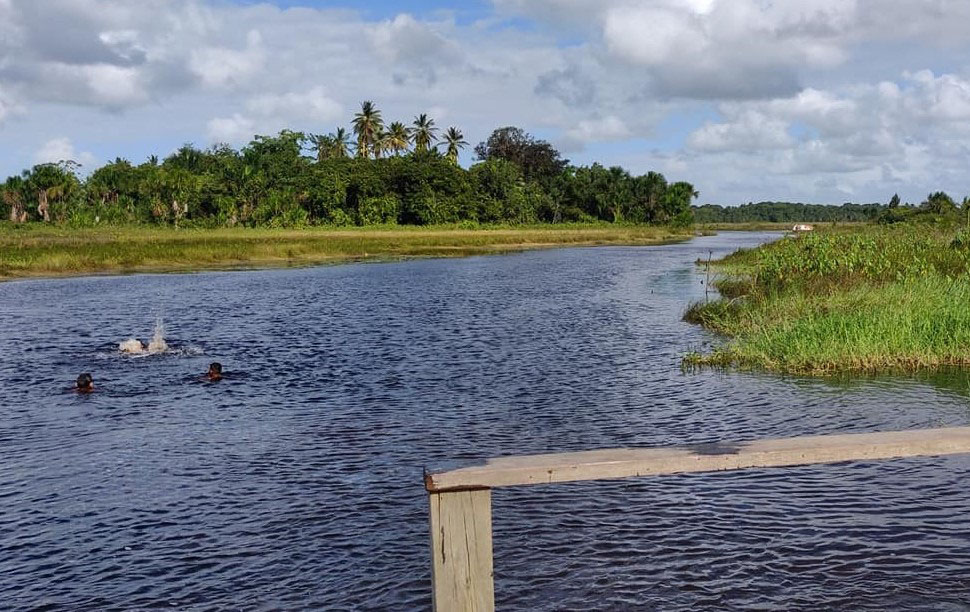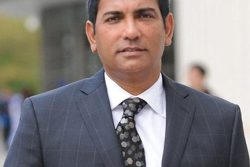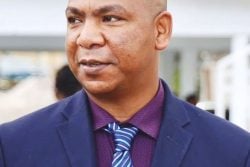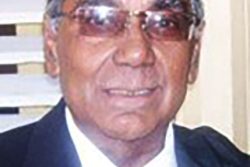Best known as “Sir Steve” or “Feets,” Gerard James Stephen La Rose is small in stature but his presence looms large.
La Rose, of Santa Rosa, Moruca, Region One (Barima/Waini), is a retired physical education (PE) teacher and sports enthusiast, who has spent years nurturing the talents of the region’s athletes. He thinks there is still much to be done and he wants government and sports organisations to put resources into honing in on sporting talents and developing them in hinterland communities.
“Georgetown is not Guyana. We have shown, though small, that we have talent in the North West, in the Rupununi, and other interior areas. We need to harness and nurture those talents to bring glory to Guyana,” he said in a telephone interview from his home in Cabucalli, Santa Rosa Island.

“You cannot send a set of basketball and hockey equipment to a place like Moruca where the people are passionate about football, cricket and swimming and to a lesser extent table tennis and volleyball,” he added.
In 2017 during Indigenous Peoples Heritage Month, La Rose was one of several hinterland teachers recognized by the Ministry of Indigenous Peoples Affairs for their sterling contribution to the education and sport sectors. He was presented with a plaque and a gold pin. And in 2018, the Region One Education Department presented him with a plaque in honour of his contribution to Guyana in the field of education and sport.
La Rose, who describes himself as “a late learner” or a “late starter”, did a one-year course in welding at the Guyana Industrial Training Centre in Georgetown from 1980 to 1981. After working at Guyana Stores Garage for five years, he returned to Santa Rosa and shortly after began teaching at Santa Rosa Primary School in 1988. In 1998 he enrolled at the Cyril Potter College of Education (CPCE) and as an option he majored in Physical Education (PE,) which no other teacher from Santa Rosa Primary, as far as he knew, had done before him.
In his early primary school days, La Rose said, he recognised that agility and ability went hand in hand with sports and they were motivators to do well in academics. “In that simple way, I knew that we could mix sports and academics for high performance in both areas so when the choice came for me to specialize at CPCE, I chose Phys Ed.”
“Throughout my primary school life, I liked sports. We played rounders, cricket, volleyball, football and table tennis. Swimming was and still remains a favourite pastime. Of course we played all these sports, making up the rules or bending them as we played,” he said.
For cricket, he said, they would use the stalk of the coconut branch to make both bat and wicket. “Most times we played windball cricket with soft balls. However, whenever we could not get proper balls, someone would bleed the balata tree for its gum. We would then boil that to our satisfaction. Alternatively, we would also make balls from the corkwood tree. We had no cricket pads in those days so if you got hit with a balata or a corkwood ball, you better make sure that your mother or grandmother had something to rub you down with. We played in yards, on the roads and whatever space we could find.”
According to la Rose, they were fortunate to have had the Roman Catholic priests and missionaries who had equipment for football, volleyball and table tennis. “Young and wanting badly to play the games, we had to face them to borrow the equipment. They would lend us but we had to take good care of them. If we damaged them that would be the end of the sport until they get new equipment,” he further recalled.
Not just a breather
Even though PE was in the school’s curriculum at Santa Rosa Primary, he said, the subject was just a breather for children and for some teachers to leave the classroom, go into the yard, do some running and jumping or play a game.
CPCE showed him that there was more to PE than just running and jumping. For him PE became a method to teach and learn in a more structured way at every level of teaching and learning. “From early childhood, middle childhood to adolescence, children require healthy bodies and healthy minds to learn and become well-rounded students and citizens,” he said.
At CPCE, he learned how to organise and run a tournament involving several teams with captains, managers, starters and other officials in place to make it competitive and successful. As a PE teacher, he said, “You learn to take on other leadership roles. You learn administration and management. You learn to be disciplined, to be punctual, to be accountable, and you build self-esteem among other attributes. It teaches you how to deal with success and failures. These are core principles taught to students writing Phys Ed as a CSEC (Caribbean Secondary Education Certificate) subject.”
On graduating from CPCE in 2000, and eager to share his new knowledge, La Rose returned to Santa Rosa to be not only a teacher but to also play a role in the wider community as a volunteer sports organiser.
On the issue of a sports organizer, La Rose said, “Moruca sub-region is in need of a paid sports organiser. A sports organiser, who has a sports background, can spot talent, can take a lead role in organising or coordinating with sports groups, sporting tournaments in the sub-region.”
Santa Rosa village, the largest Indigenous Peoples community in the country with a population of over 12,000, he noted, has several sports groups functioning in an ad hoc basis and doing a good job whenever they sponsor tournaments.
On his return to the sub-region, the Region One Education Department transferred him to Santa Rosa Secondary. La Rose’s hope was that as he had been the only PE teacher in the Moruca sub-region, and also trained to teach in multiple schools, he would have been given the opportunity to share his newly-acquired knowledge with other schools in the area. That was not to be.
“Some teachers and even some education officials do not recognize the importance of PE in the schools’ curricula. Some teachers do not want to leave the classroom and take the sunshine. All teachers are supposed to have some knowledge of Phys Ed.”
However, that did not stop La Rose from being an active member of the community and assisting as far as possible in organising schools competitions at the inter-house, inter-schools, inter-zone and district level in preparation for the Guyana Teachers Union national athletics, cycling and swimming championships (Nationals).
Although not known for the gift of gab, he also finds himself doing running commentaries at some sporting events where he is not helping an athlete or two or a team. “I do this to hype up the game and the atmosphere.”
Raw talent
One of La Rose’s favourite sports is swimming. This comes as no surprise to anyone in Moruca, as it is known and he said, “Where I live at Cabucalli, the Moruca River is literally in my backyard or front yard, depending on how you see it.”
One of his highpoints in swimming at nationals, he said, was Region One winning the swimming championship in 1994.
This feat was recognized by District One Education Department which presented the swimmers a plaque in honour of their achievement. “The swimmers gave me the plaque. However, until today we have not received the 1994 swimming championship trophy.”
“Of course, Santa Rosa swimmers represented Region One. Without a pool, our swimmers trained at the Cabucalli Landing. They had no trained coach or formal training. I was their trainer. When we took the first team out under the guidance of then head teacher Lloyd Baharally, we looked at the basic techniques and strengths of the other swimmers from Georgetown and Linden. We knew that our fresh water was heavier than the chlorinated water of the pool. So that was an advantage for our swimmers. We learned a thing or two.”
Over the years, he said, “We produced very good swimmers but they were never given the opportunity to shine.” He recalled the names of some of the swimmers like Webb Mendonca, Bruce Rodrigues, the Rebeiro brothers, best known as Monty, Chivalo and Uncle C, and Sonita Rodrigues. Mendonca went on to represent Guyana in distance swimming.
In their earlier days of training and representing District 1 (North West) (Region One) in swimming, La Rose coached his two brothers Ravel and Alex La Rose. Both brothers went on to represent Guyana through the Guyana Amateur Swimming Association at the Goodwill Swim Championships (GASA) and the Inter-Guyana Games winning gold and silver for Guyana. Ravel was the first Guyanese swimmer to swim under 60 seconds in the 100 metre freestyle race in the Goodwill Games which at the time also involved Suriname and Trinidad and Tobago.
“When we won the swimming championship in 1994 we were ecstatic. This proves we have raw talent.”
Today, he said, the pool of talent in swimming is even wider with the opening of the Santa Rosa Secondary School and the dormitories which enable students from Barama, Kwebana, Waramuri, Manawarin, Haimaracabra Creek and other places where rivers flow in the Moruca District, to live in. They all come from riverain areas where they are natural swimmers.
“The rivers are where they bathe. They can swim everyday if they so wish.”
Though he retired from teaching in 2017, he said, the secondary school still calls on him to assist in coaching the swimmers and to accompany them to Nationals. “I assist once I can do it.”
At the community level, La Rose has coached Moruca swimmers for the Amerindian/Indigenous Peoples heritage games in which the sub-region has represented Region One in swimming and has won several swimming championships, the last being in 2019. “Right now, once the river is high, we still swim, but not as a group because of the Covid-19 pandemic.”
Noting the talent that Moruca has in swimming, he is calling on the Sports Ministry and GASA to ensure that a swimming pool is built in Moruca to train swimmers in the finer techniques, to be better equipped to compete and to host competitions.
“Channel the resources into energies of the sport that people gravitate to because of their environment,” he said.
Every nook and cranny
In the game of football, talent abounds in the hinterland, La Rose said. However, he said, footballers can only make it to a certain level because opportunities are closed off to players due to lack of proper coaching in the sub region and financial constraints and support when they leave the sub-region. He believes that favouritism is also a determining factor hindering the development of individual players who display their talent. He gave the example of a player, Dwayne Rebeiro from Santa Rosa who made the Under 20 national side, but was dropped for a game to be played in Florida, USA, at the last minute without being told why. This not only disillusioned the player but the entire Moruca sub-region, he said.
Though not a football coach, he said, he assists in taking the players through certain workouts to strengthen legs, build stamina, endurance, agility among other characteristics required of them to become competitive.
He assists in endurance training of players for the Atkinson brothers of Kumaka who annually stage a football tournament. He also assisted in fitness training for the Moruca team which represented Region One and which won the last Indigenous Peoples Heritage Games held in Georgetown in 2019. Proud of all the players, he said, “I am especially proud of the goalie, Henry Phillips Jnr, who is very, very talented.”
His pet peeve, he said, is national sporting bodies calling on non-resident Guyanese to represent the country. The Lady Jaguars, for example, he said, could have used some female players from the Rupununi who were very talented but were by-passed for overseas-based players. “The Ministry of Sports programme should reach every nook and cranny in the country and should not be limited to Georgetown or to overseas-based Guyanese. Money should not be an excuse for not funding sporting programmes,” he said.









